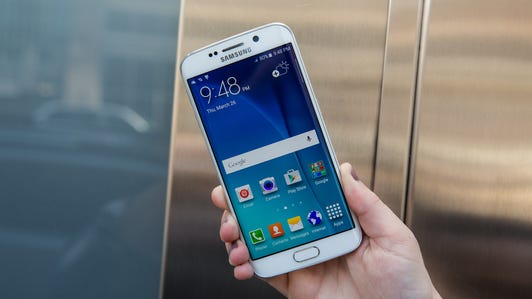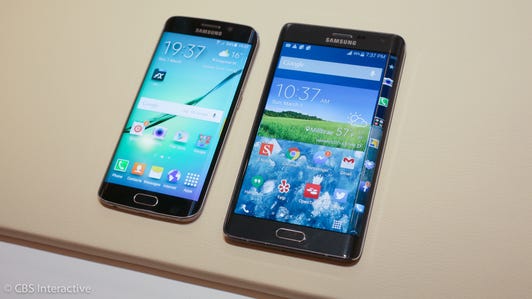
CNET
Samsung’s Galaxy S6 was supposed to turn its fortunes around. Instead, the company reported its seventh straight profit decline and will be cutting the price of its three-month-old device to attract new buyers.
The South Korean electronics giant, which released its massively redesigned smartphone in April, reported sales and profits in line with its downbeat estimate from earlier this month. Sales dropped 7.3 percent from the previous year, while Samsung’s operating profit slid 4 percent.
As a sign of more rough times ahead, Samsung warned the second half of the year “is expected to present mounting challenges” and that it “will try to improve earnings” based on the strength of its TV and chip businesses.
Samsung, which has been struggling to compete with Apple in recent quarters, had been counting on its new Galaxy S6 and Galaxy S6 Edge smartphones to revitalize its mobile business. Both devices include more premium materials than their predecessors, something consumers have been requesting for years. Still, it’s uncertain whether the phones will match the success of 2012’s blockbuster Galaxy S3, the device that helped Samsung rise to its position as the world’s smartphone king. And so far, the phones haven’t been enough to turn around Samsung’s fortunes.
“Despite the launch of Galaxy S6, improvement to earnings [from the first quarter] was quite marginal due to low smartphone shipments and an increase in marketing expenses for new product launches,” Samsung said in a press release.
The company said it will try to improve earnings in its mobile business by “adjusting the price of the Galaxy S6 and S6 Edge” and by introducing new premium, mid-range and low-end smartphone models. A person familiar with Samsung’s plans said it will cut pricing for the S6 and S6 Edge to attract new buyers. Samsung declined to provide details about the pricing changes.
The company had warned earlier this month that its operating profit for the second quarter would miss analysts’ expectations.
Samsung’s 4 percent operating profit decline from the previous year was a much smaller drop than in other recent periods, which included 30 percent drop in the first quarter, 36 percent in the fourth quarter and 60 percent in the third quarter.
See also
- Smartphones aren’t selling like they used to (it’s an Android thing)
- Samsung sets Unpacked event for August 13 in NYC
- For Apple, more success raises more questions
- Samsung expects seventh straight profit decline in second quarter
Samsung has been struggling to compete against Apple in the high-end phone market and against newcomers such as Chinese vendor Xiaomi at the low end. Apple in particular has become a bigger threat with its larger-screen devices, the 4.7-inch iPhone 6 and the 5.5-inch iPhone 6 Plus. Simply wanting a bigger display is no longer a reason to buy Samsung’s devices, and its smartphones can’t reach the low prices of those from Chinese and Indian vendors.
Industry woes
Samsung isn’t the only smartphone maker having troubles. Earlier this month, HTC reported that it had swung back into the red, and Xiaomi said its sales pace for the year had slowed significantly. Research firm Gartner said the smartphone market won’t grow as fast this year as it has before, with global shipments expected to increase just 3.3 percent from 2014.
Not even Apple has been able to avoid concerns about the global smartphone market. The company last week said it sold 47.5 million iPhones during the June quarter, up 35 percent from a year ago. But the level was below the 49.4 million expected by analysts, causing some to worry that sales were slowing down. That’s a troubling possibility for Apple, which generates about two-thirds of its revenue from the iPhone.
Samsung doesn’t break out how many devices it has sold, but analysts estimate the company shipped 71 million to 76 million smartphones during the quarter, according to The Wall Street Journal, with the two Galaxy S6 phones accounting for slightly more than 20 percent of the shipments. In the same period last year, Samsung shipped an estimated 74.5 million units, according to Strategy Analytics.
Despite Samsung mobile chief JK Shin’s prediction that the flagship S6 line will set a Samsung record for unit shipments, the Galaxy S6 Edge is expected to be in short supply for the year due both to its expected popularity and to the difficulties in crafting its screen.
Double-edged sword: Samsung’s curved Galaxy S6 Edge (pictures)






The company will host an event next month in New York to show off its newest smartphones — likely the Galaxy Note 5 and Galaxy S6 Edge Plus — and possibly a new smartwatch, which would be Samsung’s seventh wearable but the first to hit the market in a year. The company needs a homerun now more than ever, and it hopes it again can attract buyers with its big-screen smartphones.
Samsung’s IT and mobile communications division accounted for two-thirds of its revenue during the peak of the smartphone business but has recently been closer to a third of all sales. The business posted a 38 percent drop in operating profits to 2.76 trillion won ($2.4 billion). Sales in the division fell 8.4 percent to 26.06 trillion won, with mobile in particularly dropping 7.3 percent to 25.5 trillion won.
As Samsung’s mobile business struggles, investors have increasingly turned their attention to the company’s processor business. Samsung is the world’s biggest maker of memory chips and also manufactures application processors that serve as the brains of devices, including many of Apple’s iPhones. The Galaxy S6 and S6 Edge use Samsung’s Exynos applications processor instead of a Qualcomm chip, as well as flash memory and the wireless chip that connects the phone to 3G and 4G networks.
Operating profit for the semiconductor business rose 15 percent to 11.29 trillion won ($9.72 billion), slightly offsetting Samsung’s slumping smartphone results.
For the company overall, sales fell 7.3 percent from the previous year to 48.54 trillion won ($41.8 billion). Its operating profit slid 4 percent to 6.9 trillion won ($5.9 billion), and the company also reported net income of 5.75 trillion won, a 8 percent decline from the year-ago period.
Samsung earlier this month estimated its operating profit for the three-month period ended June 30 would be 6.9 trillion won, a decline of 4.2 percent from the year-ago period. Samsung’s profit expectations fell short of the average analyst estimate of 7.2 trillion won compiled by Bloomberg. It also said revenue would come in at 48 trillion won, compared with analysts’ average estimates of 53 trillion won.
Before its recent string of declines, Samsung had posted five consecutive quarters of record profits.
Updated at 5:35 p.m. PT: Adds Samsung declining to comment.



